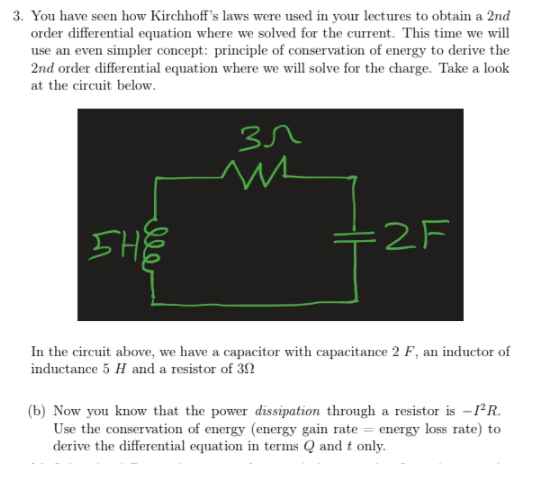3. You have seen how Kirchhoff's laws were used in your lectures to obtain a 2nd order differential equation where we solved for the current. This time we will use an even simpler concept: principle of conservation of energy to derive the 2nd order differential equation where we will solve for the charge. Take a look at the circuit below. 5HE =2F
3. You have seen how Kirchhoff's laws were used in your lectures to obtain a 2nd order differential equation where we solved for the current. This time we will use an even simpler concept: principle of conservation of energy to derive the 2nd order differential equation where we will solve for the charge. Take a look at the circuit below. 5HE =2F
College Physics
1st Edition
ISBN:9781938168000
Author:Paul Peter Urone, Roger Hinrichs
Publisher:Paul Peter Urone, Roger Hinrichs
Chapter22: Magnetism
Section: Chapter Questions
Problem 83PE: Integrated Concepts (a) What is the direction of the force on a wire carrying a current due east in...
Related questions
Question

Transcribed Image Text:3. You have seen how Kirchhoff's laws were used in your lectures to obtain a 2nd
order differential equation where we solved for the current. This time we will
use an even simpler concept: principle of conservation of energy to derive the
2nd order differential equation where we will solve for the charge. Take a look
at the circuit below.
SHE
=2F
In the circuit above, we have a capacitor with capacitance 2 F, an inductor of
inductance 5 H and a resistor of 3N
(b) Now you know that the power dissipation through a resistor is -1*R.
Use the conservation of energy (energy gain rate = energy loss rate) to
derive the differential equation in terms Q andt only.
Expert Solution
This question has been solved!
Explore an expertly crafted, step-by-step solution for a thorough understanding of key concepts.
Step by step
Solved in 2 steps with 1 images

Knowledge Booster
Learn more about
Need a deep-dive on the concept behind this application? Look no further. Learn more about this topic, physics and related others by exploring similar questions and additional content below.Recommended textbooks for you

College Physics
Physics
ISBN:
9781938168000
Author:
Paul Peter Urone, Roger Hinrichs
Publisher:
OpenStax College


College Physics
Physics
ISBN:
9781305952300
Author:
Raymond A. Serway, Chris Vuille
Publisher:
Cengage Learning

College Physics
Physics
ISBN:
9781938168000
Author:
Paul Peter Urone, Roger Hinrichs
Publisher:
OpenStax College


College Physics
Physics
ISBN:
9781305952300
Author:
Raymond A. Serway, Chris Vuille
Publisher:
Cengage Learning

College Physics
Physics
ISBN:
9781285737027
Author:
Raymond A. Serway, Chris Vuille
Publisher:
Cengage Learning

Physics for Scientists and Engineers, Technology …
Physics
ISBN:
9781305116399
Author:
Raymond A. Serway, John W. Jewett
Publisher:
Cengage Learning

Principles of Physics: A Calculus-Based Text
Physics
ISBN:
9781133104261
Author:
Raymond A. Serway, John W. Jewett
Publisher:
Cengage Learning